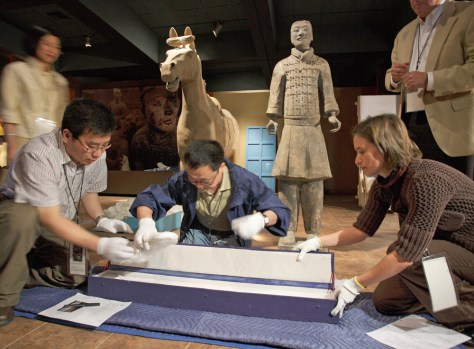It is the burden of a registrar to be constantly asked, ‘So
what exactly is it that you do?’ Sometimes even by other museum
people. To this age-old question, a registrar can be counted upon to sigh
heavily and launch into an explanation, all the while dying a little inside.
I am writing today to rectify this wrong. Museum people and
all you other museum lovers- listen up! I will explain to you what a registrar
does so that you will never make this tragic mistake again. Let there be no
doubt for all in the museum world, but particularly on the exhibitions circuit,
your registrar is your best friend, and you never EVER want to annoy them.
Although you inevitably will.
 |
| Nope registrars never do this. In fact they make sure that fool on the left is getting fired for not wearing gloves. |
It is the core of a registrar’s job to be annoyed by
curators. Wait, scratch that, we will get to that a bit later. Let’s go back to
basics and simply say that a registrar’s job is to do the registry work for the
museum. Not more enlightened? Registry work is all things to do with the legal
and logistical aspects of acquiring or disposing objects, whether for the
collections or for loans. That means every object you see in an exhibition
which says ‘on loan from…’ is only there because the registrars from the
lending and borrowing institutions did days, possibly weeks, worth of work to
make it happen.
That seems like a silly job, you might say. Why not just put
the thing in the back of your car and drive it over to the other museum?
Because it is also the registrar’s job to ensure that museums are acting
according to industry standards at all times- and that means making sure every
part of a loan ‘nail to nail’ is done with the utmost professionalism. That’s
important because if you slip below museums standards of logistics, packing,
conservation, or display the Lending institution can revoke the loan at any
time, or even worse, you can lose your insurance cover.
Registrars are also in charge of all kinds of legal aspects
about acquiring and disposing objects. Can you buy an object off the black-market
that is made of endangered animal furs and was also looted by the Nazis? Of
course not, and registrars are here to make sure crazy curators don’t.
Aside from any technical definition of what registry work
includes, a registrar is essentially the middleman between all the different
museum departments to make sure everything runs smoothly. A registrar will
often coordinate between curatorial and conservation to make sure that objects
for exhibition are condition checked, conserved and packed as necessary. They
also work with donors to organise acquisitions and returns of objects. A good
registrar will make sure everyone is talking to everyone else during a project
and that everything gets done to time.
 |
| We can only assume the registrars are the ones in the background, looking on critically. |
This also means that people tend to get annoyed with or even
dislike registrars. Curators will often be driven crazy by registrars constantly
pushing paper at them, telling them what they can and can’t do, or nagging them
about deadlines. On the flip side, curators drive us crazy sometimes changing
their exhibition plans, object lists, move in dates and god knows what else.
And don’t even get me started on designers who just really want to display an
object under a waterfall, or want people to experience a priceless 18th
century object through the sense of taste. These things sound like fun and
probably look cool, but basically go against everything a museum stands for in
terms of protecting heritage.
To be fair, the work of a registrar varies across
institutions. In some museums registry work is done by the curator, in others
it might be combined with documentation, and in some places it falls to
exhibitions teams. What I can tell you is, whatever wrapping they come in, on
any exhibition project there will be a registrar type person, and you need to
make them your best friend. They have the contacts with museum logistics
companies, they know who’s who in conservation and they can give you all kinds
of paperwork related advice.
So here’s to you registrars, unsung heroes of the museum
world. You make exhibitions happen, you make sure the various bickering
departments work together, you keep museums accredited and you use your mad-organization
skills to keep objects safe at all times. Now go to work and hug your registrar, they
probably need one after how stressed you’ve made them.
whow and I bet you rarely hear "goof job registrar" mom and kies
ReplyDelete